Year: 2020
Telecompaper: FTTH spurs growth in Netherlands broadband market
FTTH accounted for all of the new growth on the Netherlands broadband market in Q3 2020, the latest research by Telecompaper shows. Cable operators lost broadband subscribers for the first time on record, suggesting the fiber market is really taking off.
The mass market (consumer + SOHO) added 32,000 fixed broadband subscribers in the third quarter, the same number as in Q2 and slightly less than the year-earlier period, according to Telecompaper’s quarterly Dutch Broadband report.
FTTH growth accelerated to 68,000 new connections, while cable lost 8,000 customers and DSL shed 28,000 lines. The decrease in cable customers was driven by market leader Ziggo, which lost 7,000 broadband subscribers in the period. This is the first time it has lost customers since launching cable broadband. Nevertheless, Ziggo remains market leader, with over 43 percent of Dutch broadband subscribers.
KPN was the biggest gainer on the market, adding 37,000 broadband customers in Q3. KPN’s growth is driven by the takeover of customers from its discontinued Telfort brand and an accelerating FTTH roll-out in the past year. The KPN brand added over 40,000 FTTH subscribers in the quarter, more than four times the rate of growth in Q3 2019. This increased its share of the total FTTH market to 53.5 percent of connections.
T-Mobile Netherlands also continued to grow, adding 31,000 broadband subscribers. This makes it the third-largest broadband brand with a 5.3 percent market share. In the FTTH segment, T-Mobile is number two with just over 13 percent of connections, followed closely by Caiway with 12 percent.
“The figures suggest KPN’s strategy to speed up its FTTH roll-out is starting to pay off and stem the loss of broadband subscribers,” said Kamiel Albrecht, Telecompaper’s senior research analyst for the Dutch fixed market. “Ziggo is not sitting still and should soon complete its nationwide roll-out of gigabit service, putting the companies on more equal footing. More intensive marketing of the top speeds can be expected in 2021, as the importance of broadband remains top of the mind during the pandemic.”
The above figures are based on Telecompaper’s continuous analysis of the Dutch broadband market. For a comprehensive overview of market data and trends, including a five-year forecast, the Q3 2020 edition of the Dutch Broadband report is now available for purchase on the Telecompaper website.
From Global Data:
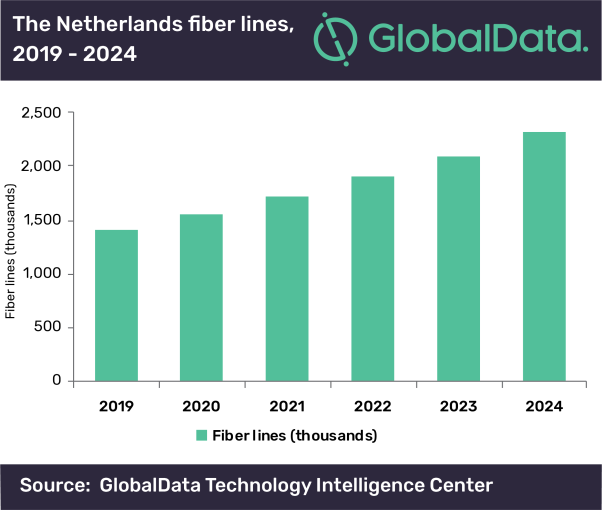
Reference:
https://www.telecompaper.com/news/fibre-dominates-dutch-broadband-growth-in-q3-2020–1364963
Deutsche Telekom Progress Report on 5G and FTTH
Deutsche Telekom (DT) is rounding out 2020 with an upbeat announcement on its achievements and ambitions in 5G and FTTH. The largest telco in Germany highlighted progress in the rollout of 5G and uptake of the technology in its home market. Two-thirds of the population can use 5G, which was its target figure for the end of year, as outlined in the summer, with 45,000 5G-capable antennas deployed.
Two thirds of people in Germany can now use 5G on the Telekom network. 45,000 antennas are already transmitting on 5G. Here too, Deutsche Telekom intends to continue expanding rapidly. In the coming year, the 80 percent mark for population coverage is to be reached with 5G. By 2025, it should be 99 percent – as announced.
“Never before have we been able to set up a new network technology faster than now with 5G. The fact that just over a year after the frequency auction, two-thirds of the population can already use 5G is the fastest expansion in the history of mobile communications. Telekom is the 5G engine in Germany. And 2020 was clearly the 5G year,” said DT CEO
With 5G, Deutsche Telekom is combining expansionan. in two frequency bands. On the high-reach 2.1 GHz frequency, high mobile bandwidths will be brought to rural areas in particular. For example, the offshore island of Helgoland is now also being supplied with 5G. The 3.6 GHz frequency provides high-speed 5G where many people move around in a small area, such as in large cities. It is now also used at Frankfurt Airport. The technology will also be installed at Berlin’s BER airport. New are also the 5G Highspeed antennas in Bremen, Hanover and Nuremberg. This means that 13 major cities are already benefiting from 5G in gigabit speed.
“Telekom keeps its promises. This applies in particular to network expansion. Right now, the Telekom network is proving its worth. It was the right decision to put fiber optic in every street and thus to enable fast networks from Telekom for over 80 percent of all households. Home offices are possible throughout the country. Now comes the next step: Fiber optic to the home and 5G. Here too, we have a plan that we are working through step by step. Despite Corona, our expansion is running at full speed,” says Deutsche Telekom CEO Tim Höttges. “And to make sure that everyone in Germany is part of it in the future, we are now really getting going. To achieve this, we have been investing around five and a half billion euros a year in Germany for years. Most of it will go into our network.”
The telco also revealed that every other contract or contract extension it sells now includes a 5G device, a figure that suggests users are starting to embrace the technology.
“2020 was clearly the 5G year,” said Srini Gopalan, who took over as head of Deutsche Telekom in Germany just over a month ago. Coverage of two-thirds of the population is certainly a significant milestone.
“We are building for digitization in Germany. The better the framework conditions for investment, the smoother the fiber-optic expansion will run. New technology and new times also require new and flexible answers,” says Tim Höttges. “What additionally helps us with the expansion are, for example, quick approvals. On the other hand, the acceptance of alternative laying methods beyond civil engineering would simplify and accelerate many things. But it also requires a clear commitment from the competition to FTTH. This is a task for society as a whole that we must tackle together. We too have learned our lesson and are focusing much more strongly on cooperation, especially with local suppliers.”
Deutsche Telekom has rolled out FTTH to around 2 million households in Germany, having added somewhere between half a million and 600,000 in 2020: its description of the number of households added varied in the announcement. Last year it rolled out full fiber to 270,000 homes. Going forward, DT is shooting for 2 million homes added per year.
“FTTH is the key to the next surge in digitization. We have revolutionized our processes to achieve this,” says Srini Gopalan, member of the Deutsche Telekom Board of Management responsible for Germany. “Our Fiber Factory is now really taking off. This means we are bringing the fiber directly to where it will be needed more and more in the future: In households, businesses and schools. In the city and in the country.”
References:
Ambani: Reliance Jio to deploy 5G network in second half of 2021
Reliance Jio today announced that it will roll-out 5G services in India in the second half of 2021. The announcement was made by the company’s CEO, Mukesh Ambani (Asia’s richest man) at the fourth annual (online this year due to COVID-19) of the India Mobile Congress.
Ambani revealed that the company plans to implement 5G service in the second half of 2021, while restating that the 5G network by the company will be built indigenously. Jio is likely to be the first service provider to bring the technology to the country. It’s believed to be based on Open RAN technology, but that has yet to be confirmed by Jio.
“India is today among the best digitally connected nations in the world. In order to maintain this lead, policy steps are needed to accelerate the early rollout of 5G, and to make it affordable and available everywhere. I assure you that Jio will pioneer the 5G Revolution in India in the second half of 2021. It will be powered by the indigenous-developed network, hardware and technology components.”
Jio has developed its own 5G solution, which it hopes to sell in different countries after deploying it in its own network. Jio Platforms, with over 20 startup partners, is building capabilities in artificial intelligence (AI), cloud computing, big data, machine learning and blockchain. Jio Platforms raised funding of more than $20 billion earlier this year. Several firms, including Qualcomm, Google and Facebook, invested in the company.
“Jio’s 5G service will be a testimony to your inspiring vision of Atma Nirbhar Bharat. I can say with utmost confidence that 5G will enable India to not only participate in the Fourth Industrial Revolution but also to lead it.”
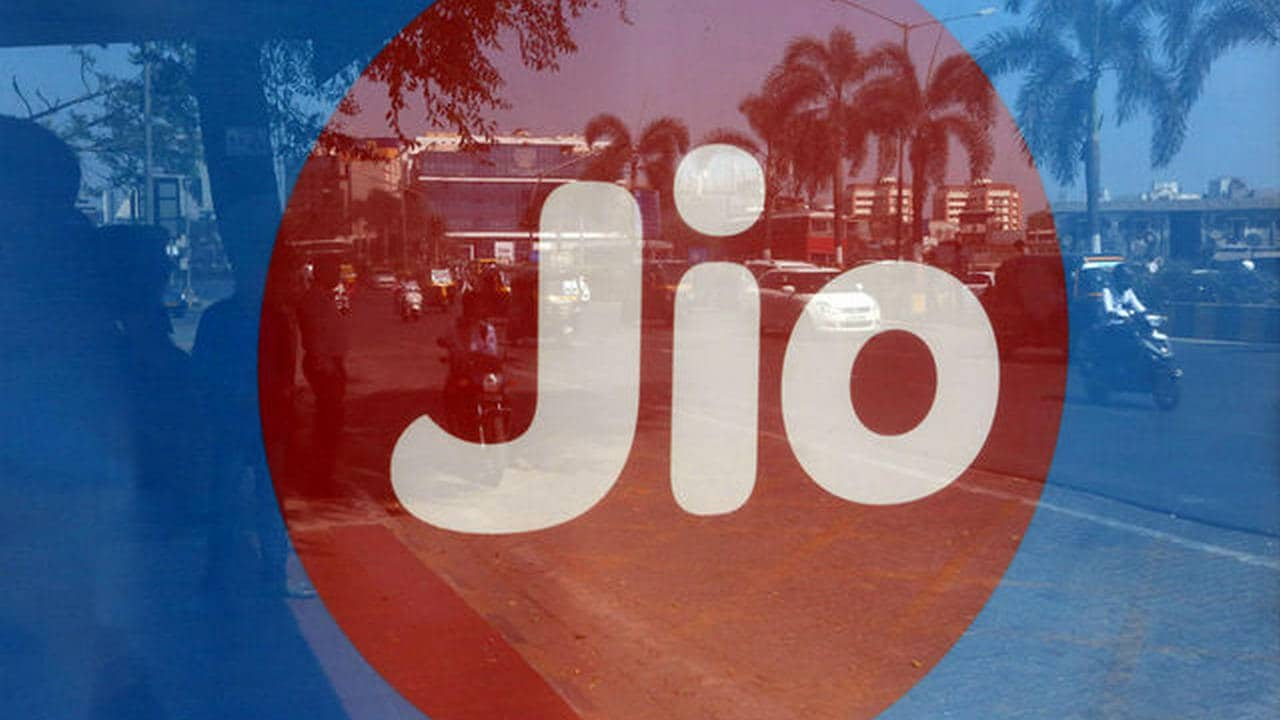
“The Indian economy will not only bounce back but will also grow with unprecedented acceleration. India can — and India will — prove cynics wrong by becoming a $5 trillion economy. It will be a More Equal India… With increased incomes, increased employment, and improved quality of life for 1 billion Indians at the Middle and Bottom of the Economic Pyramid.”
You can watch a video of Ambani’s speech here along with news reporter commentary.
Earlier this year, Qualcomm had announced that it was working with Jio Platforms and its wholly owned subsidiary, Radisys Corporation, to develop open and interoperable interface compliant architecture based 5G solutions with a virtualized RAN. The two companies had achieved the 1Gbit/s milestone on Jio’s 5G New Radio (NR) software.
While Jio has been asking the government to expedite the 5G spectrum auction, the other private telcos, Bharti Airtel and Vodafone Idea, believe India is not yet ready for 5G technology. In particular, Bharti Airtel’s chairman Sunil Mittal claiming that the rollout of 5G technology in India will take another two-three years. Mittal has said that the next generation of mobile technology will need more time to be rolled out across the country. Airtel’s decision makers, including its chief executive, Gopal Vittal, has said in the past that the ecosystem for 5G is underdeveloped and that spectrum is expensive.
Ambani concluded his address saying, ” We are about to step into a glorious decade of the India story, with the Digital India Mission playing the role of the principal accelerator. Nothing can stop India’s rise, not even COVID-19. This is our chance to create history.”
References:
https://www.lightreading.com/asia/indias-jio-to-launch-5g-in-2021/d/d-id/765966?
ITU Virtual Digital World SME Awards for Connectivity, Smart Cities, e-Health, Digital Finance
- Connectivity – new approaches to increasing universal access to the internet
- Smart cities, smart living – improving urban life in areas such as energy, transport, planning, education
- E-health – improve healthcare through remote diagnosis and treatment
- Digital finance – increase access to the digital economy for the banked and unbanked
From very small satellite-powered remote IoT sensors to mobile finance for smallholder farmers, navigational platforms for smart public transit or portable electrocardiograms for remote diagnosis and much, much more, this virtual edition of the ITU Digital World Awards – open to all small- and medium-sized enterprises (SMEs) worldwide – celebrated creativity and innovation in digital solutions meeting real-world needs.
- Astrome from India, using millimetre wave wireless communication to provide fibre-like backhaul capacity for 4G and 5G infrastructure, in the Connectivity category;
- BusMap from Viet Nam, providing smart public transit solutions through navigation algorithms and advanced user experience features for consumers, corporates and governments in the Smart cities, smart living category;
- Appy Saude from Angola, for their e-health platform identifying the nearest pharmacy location, best price and availability of medicines, in the E-health category;
- OKO Finance from Israel, providing smallholder farmers with crop insurance and access to digital financial tools through simple mobile technologies, in the Digital finance category.
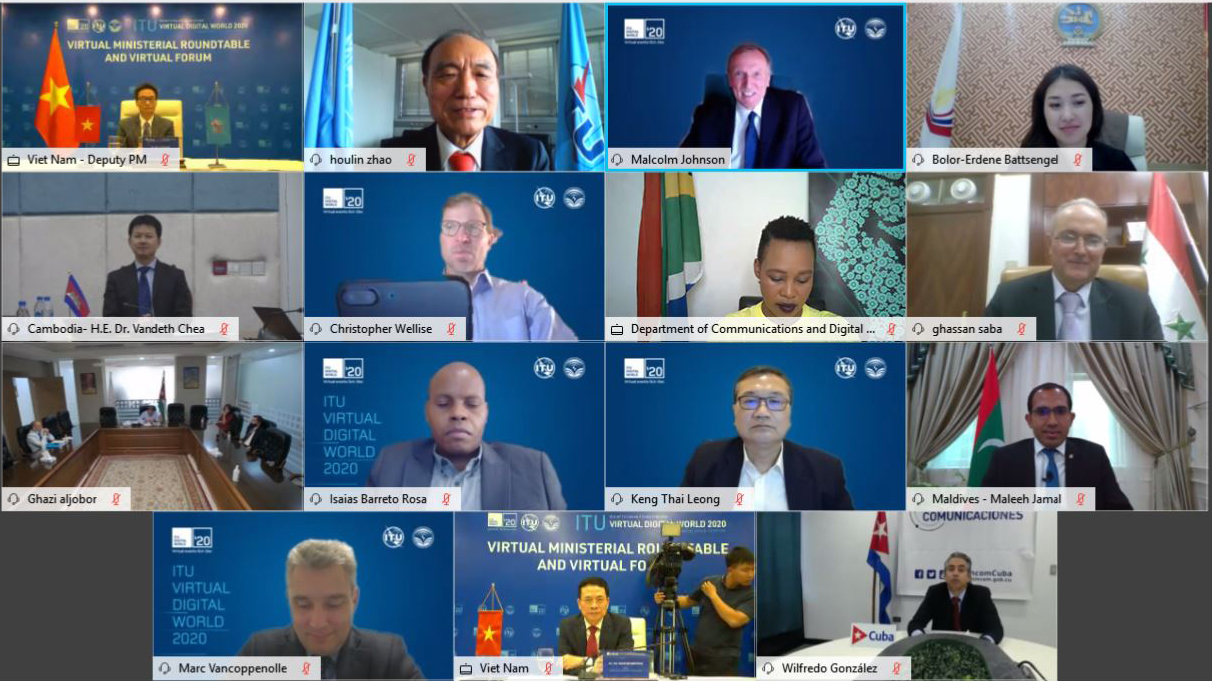

Progress in 5G private networks and Open RAN
Harry Baldock of Total Telecom writes, “The month of November was one of quiet progress for 5G, with more momentum steadily being gained for long-term trends towards private network deployments and open RAN innovation.”


Private 5G networks could be viable connectivity options for major industries like manufacturing and shipping, giving them not only access to the latest technologies to enhance efficiency, but also the flexibility to structure their network however they please.
In Europe, the German telecom regulator announced in November that it has awarded 88 licences for private 5G networks this year and expects more to come. For example, Nokia recently installed a private 5G network in Nuremburg for industrial IoT specialist MYNXG. In France, electronics manufacturer Lacroix is working with with Orange and Ericsson to create a 5G factory, and in the UK BT is installing a 5G network into Belfast Harbour, while Huawei is creating a private 5G testbed in Cambridge.
There has also been significant movement in the U.S., with General Motor’s new Factory ZERO installing a private 5G network from Verizon to manufacture the next generation of electric vehicles.
However, it should be remembered that despite its promise, private 5G networks are also still very much in their infancy, with a survey from STL Partners showing that the majority of enterprises still rely primarily on Wi-Fi and ethernet or fixed broadband for their connectivity needs.

Meanwhile, Open RAN has been gaining momentum for some months now as we reported yesterday in this IEEE Techblog post. In November, Dish and Qualcomm announced that they are set to work together on the U.S.’s first Open RAN-compliant (which spec?) 5G network. Similarly, in the UK, Vodafone’s August pilot for Open RAN, that took place in Wales, is being scaled up to 2,600 Open RAN sites in Wales and England, potentially using them to replace Huawei gear.
Meanwhile, companies like Mavenir continue to rapidly develop open RAN solutions, recently boasting of supporting 2G–5G for its open RAN packet core, thanks to a recent acquisition of ip.access.
Baldock concludes, “it seems fair to say that Open RAN is here to stay and is no longer something of a novelty. While many issues remain around things like standardization (e.g. no liaison with either ITU, ETSI or 3GPP) the movement is beginning to see increasing interest from operators and policymakers alike.”
…………………………………………………………………………………………………………………………………….
References:
https://techblog.comsoc.org/2020/12/04/omdia-and-delloro-group-increase-open-ran-forecasts/
German Telecom Regulator awards 5G private network licenses in the 3.7GHz to 3.8GHz band
Omdia and Dell’Oro Group increase Open RAN forecasts
In an updated forecast out this month, Informa owned Omdia predicts that Open RAN is likely to generate about $3.2 billion in annual revenues by 2024. That would make it about 9.4% of the total 4G and 5G cellular market.
That forecast implies a massive increase on last year’s sales of just $70 million (see Dell’Oro forecast below), and Omdia’s Open RAN numbers have been raised significantly in the last few months. Previously, it was expecting Open RAN to generate about $2.1 billion in revenues in 2024.
Telco buy-in and support is critical, according to Daryl Schoolar, practice leader at Omdia responsible for the firm’s Open RAN forecasts. “Mobile operators remain the real driving force behind the development of open virtual RAN,” he says. “I see this as a positive sign for the market versus other technology and network developments I have seen during my career that were driven by vendors and ultimately went nowhere. The bigger market opportunity is with brownfield deployments, but this takes more time to accomplish as operators have to integrate open RAN with their legacy network systems and make sure those legacy networks and services are not adversely impacted,” Schoolar added.
Here are some of the network operators that have committed to OpenRAN:
- Japan’s Rakuten, which already operates a 4G and 5G network based on open RAN. While customer numbers remain low, its early success has undoubtedly encouraged others.
- Telefónica and Rakuten have announced a partnership to accelerate the development of Open RAN technology for 5G access and core networks, and the associated operations support systems (OSS). They will jointly test, develop and procure Open RAN systems.
- Dish Network, is another greenfield builder that is using open RAN technology to roll out a fourth mobile network in the US. which is primarily focused on business customers.
- Orange sees a role for Open RAN vendors to provide more “plug and play” indoor coverage for businesses through 2021 and 2022. Open RAN could also play a part in the macro network, although that is more likely to come from 2023, and still requires work.
Dell’Oro Group (see forecast below) says: “Dish is running into delays in the US market, Rakuten is moving forward at a rapid pace in Japan deploying a variety of both sub 6 GHz and mmWave RAN systems. In addition, some of the Japanese telecom equipment vendors (e.g. NEC) are reporting that the lion share of their radio shipments are already O-RAN compatible.”
Open RAN progress:
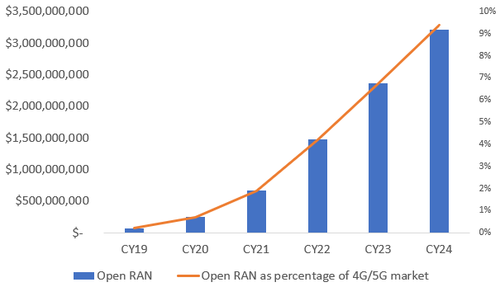
Source: Omdia
……………………………………………………………………………………………………………………
Omdia notes that Open RAN is a potential dilemma for the big telco equipment vendors like Ericsson and Nokia (which intends to supply Open RAN products). The risk is that it decreases their market share for traditional cellular gear, as wireless network providers opt for Open RAN products developed by alternative suppliers. Yet open RAN might also bring opportunities in new markets for the old guard. “Either way, vendors cannot ignore this market trend,” says Omdia.
Gabriel Brown, a principal analyst at Heavy Reading, a sister company to Omdia and Light Reading, says he is positive about Open RAN but warns against expectations of liftoff next year. “The right timeline to view it on is a four-to-five-year timeline,” he said in a discussion with Light Reading this week. “I think next year continues to be primarily trials, scaling the trials … and some operators moving into production networks, but I don’t think it’s the year when it all takes off.”
Separately, Dell’Oro Group’s latest Open RAN forecast, projects that Open RAN baseband and radio investments—including hardware, software, and firmware excluding services—will more than double in 2020 with cumulative investments on track to surpass $5B over the forecast period.
Open and Virtual RAN continues to gain momentum, bolstered by Ericsson now formalizing its support with its Cloud-RAN announcement. The uptake remains mixed. In this blog we will discuss three key takeaways for the 3Q20 quarter including:
1) The primary objective of Open RAN is to address market concentration and vendor lock-in;
2) Open RAN revenues are trending ahead of schedule;
3) Not all Open RAN is disruptive.
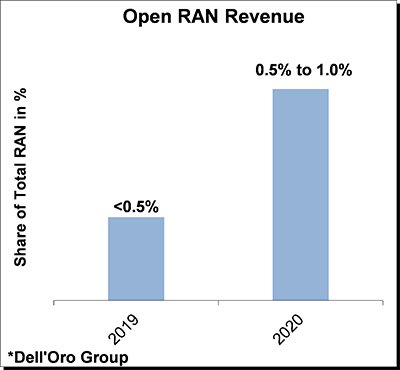
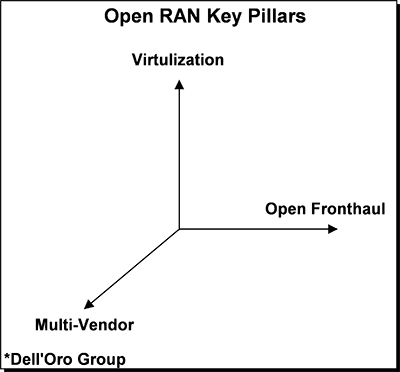
Source: Dell’Oro Group
Dell”Oro says that the more favorable Open RAN outlook to a confluence of factors including:
- Verification from live networks the technology is working in some settings;
- Three of the five incumbent RAN suppliers are planning to support various forms of Open RAN – “Partial Open RAN” (open and virtual but not multi-vendor) are at this juncture captured in the Open RAN estimates meaning we require the first two pillars but we are excluding the third multi-vendor requirement as a necessity to reflect the Open RAN movement;
- The geopolitical uncertainty has escalated significantly in the past six months, with multiple operators reassessing and/or reviewing their reliance on Huawei’s RAN portfolio, resulting in an improved entry point for the Open RAN suppliers;
- Progress with full virtualization is firming up, with multiple suppliers announcing the commercial availability of V-RAN, consisting of both vCU and vDU;
- Operators are increasingly optimistic the technology will move beyond the rural settings for brownfield deployments;
- Policies to stimulate Open RAN are on the rise.
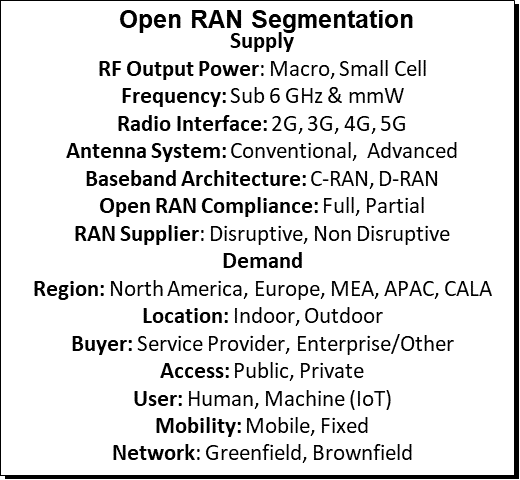
Source: Dell’Oro Group
“We estimate total open RAN revenues are tracking ahead of schedule,” wrote Stefan Pongratz of Dell’Oro Group, noting the market research firm recently raised its 2020 open RAN revenue forecast to $300,000 from $200,000. “On the other hand, the lion share of any ‘security’ related RAN swaps are still going to the traditional RAN players, suggesting the technology for basic radio systems remains on track but the smaller players also need to ramp up investments rapidly to get ready for prime time and secure larger brownfield wins.”
…………………………………………………………………………………………………………….
References:
https://www.lightreading.com/open-ran/open-ran-will-be-$32b-market-in-2024-says-omdia/d/d-id/765889?
https://omdia.tech.informa.com/OM011039/Open-RAN-commercial-progress-in-2020 (must be an Omdia client to access)
https://www.delloro.com/open-ran-results-mixed-in-3q20/
Dell’Oro: Telecommunication Equipment Market 1Q20 to 3Q20 +China’s New 5G Base Stations
Preliminary estimates by the Dell’Oro Group suggest the overall telecom equipment market advanced 9% Year-Over-Year (Y/Y) during 3Q20 and 5% Y/Y for the 1Q20-3Q20 period. That market includes: Broadband Access, Microwave & Optical Transport, Mobile Core & Radio Access Network, SP Router & Carrier Ethernet Switch (CES).
The analysis contained in these reports suggests revenue rankings remained stable between 2019 and 1Q20-3Q20, with Huawei, Nokia, Ericsson, ZTE, Cisco, Ciena, and Samsung ranked as the top seven suppliers, accounting for more than 80% of the total market. At the same time, revenue shares continued to be impacted by the state of the 5G rollouts in highly concentrated markets.
Huawei and ZTE are both on course to gain two percentage points of market share each this year, at the expense of Nokia, Cisco and Samsung. With investments in China outpacing the overall market, we estimate Huawei and ZTE collectively gained about 3 percentage points of revenue share,” wrote Dell’Oro Analyst Stefan Pongratz in his blog on the matter, implying they actually grabbed around 1.5 percentage points each.
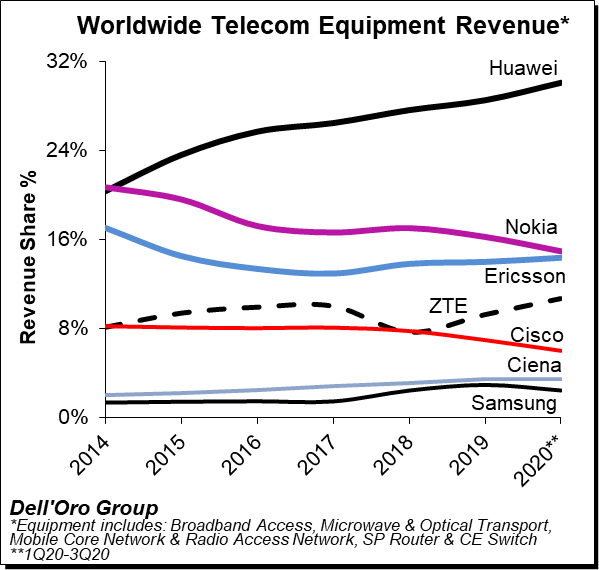
Dell’ Oro estimates the following revenue shares for 2019 and the 1Q20-3Q20 period for the top seven suppliers:

- Following the 4% Y/Y decline during 1Q20, the positive trends that characterized the second quarter extended into the third quarter, underpinned by strong growth in Optical Transport and multiple wireless segments including 5G RAN, 5G Core, and Microwave Mobile Backhaul. Technology segments that were impacted more materially by COVID-19 and the lockdowns during 1Q20 continued to stabilize in the quarter.
- Preliminary estimates indicate increasing Mobile Infrastructure and Optical Transport revenues offset declining investments in Microwave Transport and SP Routers & CES for the 1Q20-3Q20 period.
- The overall telecom equipment market continued to appear disconnected from the underlying economy. While the on-going transition from 4G to 5G is helping to offset reduced capex in slower-to-adopt mobile broadband markets, we also attribute the disconnect to the growing importance of connectivity and the nature of this recession being different than in other downturns improving the visibility for the operators.
- With investments in China outpacing the overall market, we estimate Huawei and ZTE collectively gained about 3 percentage points of revenue share between 2019 and 1Q20-3Q20, together comprising more than 40% of the global telecom equipment market.
- The Dell’Oro analyst team has not made any material changes to the overall outlook and projects the total telecom equipment market to advance 5% to 6% in 2020 and 3% to 4% in 2021. Total telecom equipment revenues are projected to approach $90 B to $95 B in 2021.
………………………………………………………………………………………………………………………………………………………………..
Judging from a report by China Daily “China to build 1 million new 5G stations in 2021.” it appears Huawei and ZTE will continue to increase their telecom equipment market share. Reporter Ma Si of China Daily spoke to Wu Hequan, an academician at the Chinese Academy of Engineering, who reckons China will build over a billion 5G base stations next year, taking the grand total to 1.7 million by the end of the year.
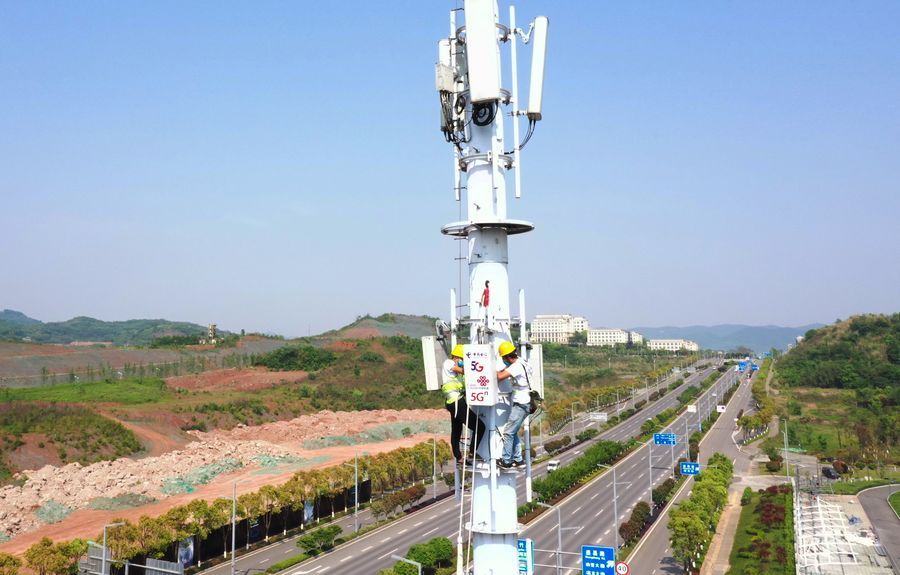
China workers working at the construction site of a 5G base station at Chongqing Hi-tech Zone in Chongqing, Southwest China. [Photo/Xinhua]
“As the construction of 5G networks accelerates, the cost of building each 5G base station will go down,” said Wu. “Even if Chinese telecom carriers earmark the same amount of 5G investments in 2022 as they have done this year, they can build far more 5G base stations next year than this year. I believe Chinese telecom carriers will build more than one million 5G base stations next year, though the specific construction targets will have to wait for the telecom carriers’ official announcements.”
China Mobile, China Telecom and China Unicom did not immediately respond to requests for comment from China Daily.
Wu’s remarks are in line with China’s top industry regulators’ predictions the nation will “moderately” push ahead 5G construction in the next few years. The Ministry of Industry and Information Technology said in October as the country is set to enter a lead-in period in the next three years, China will continue to build 5G networks in a rhythm that is moderately ahead of schedule, so the wider coverage of 5G can help promote its use in more industrial and consumer scenarios.
That lead-in period, according to some industry insiders, means new products, new formats and new models of 5G application are constantly emerging and such applications are shifting from single application to large-scale and systemic scenarios.
China seems to be all the more determined to ensure its domestic telecoms industry goes from strength to strength. In response to the threat to the U.S. from China, John Ratcliffe wrote in the Wall Street Journal (on-line subscription required for access): “Beijing is preparing for an open-ended period of confrontation with the U.S. Washington should also be prepared. Leaders must work across partisan divides to understand the threat, speak about it openly, and take action to address it.”
…………………………………………………………………………………………………………………………………………………………..
References:
Key Takeaways—Telecommunication Equipment Market 1Q20 to 3Q20
Chinese telecoms kit vendors gained global market share this year
https://www.chinadaily.com.cn/a/202012/02/WS5fc74e99a31024ad0ba99633.html
FTTH accelerating in Europe: penetration forecast to reach 65% in 2026
The number of FTTH/B subscribers in Europe is expected to more than double in the next six years, to 208 million in 2026 compared to an estimated 86 million this year. According to the forecasts by iDate presented at the annual (this time virtual) FTTH Council Europe conference, the number of homes passed by fiber will grow over the same period to 317 million from 195 million. That translates into approximately two-thirds fiber network penetration rate, compared to less than half currently.

Roland Montagne of Idate DigiWorld presenting during the second day of the conference.
……………………………………………………………………………………………………………………………………………………………………………………………………..
The forecasts cover 39 countries across Europe. Idate also looked at the 27 EU members plus the UK and found similar growth rates. The number of FTTH/B subscribers in these countries is expected to roughly triple by 2026, to 148 million from 49 million this year, driven by accelerating roll-out in key markets such as Germany, the UK and Italy. Homes passed in the 28 countries are estimated at 202 million in 2026, versus 105 million this year. Some markets are expected to experience an outstanding growth in the number of homes passed in 2026 compared with 2019, including Germany (+730 per cent), United Kingdom (+548 per cent) and Italy (+218 per cent).
While the Covid pandemic has underlined the need for fast broadband at home, other trends were already underway to support fibre take-up, the researchers said. These include the upcoming switch-off of copper networks, more network-sharing and co-investment agreements, strong commitments from public authorities to FTTH, and the need for fiber backhaul on 5G mobile networks.
In the country rankings, it is predicted that Russia will continue leading in terms of FTTH/B homes passed. However, it is also anticipated that Germany will bag the second spot in the 2026 ranking.
In terms of subscribers, the forecast predicts a further increase to around 148 million in 2026 for EU27+UK and approximately 208 million for EU38+UK. The FTTH/B take-up rate is likely to reach 73 per cent in 2026, demonstrating an upward trend compared with a recorded 23.4 per cent in 2012.
The FTTH Council Europe published a separate study by Wik following up on its research last year into the progress with copper shutdowns. While the situation is fragmented in Europe, progress in some countries shows turning off copper and switching to fibre can have significant benefits for the economy and the environment, as well as improving reliability and customer satisfaction.
Consumer awareness about the copper shutdown has been a positive factor in some countries in stimulating fiber take-up. The latest forecasts on fibre take-up are also based in part on the increased perception of broadband’s importance since the coronavirus pandemic. Nevertheless, additional measures by policy-makers aimed at increasing take-up are still crucial for Europe to benefit from the potential of full fiber, the Council said.
FTTH/B deployments are intensifying across Europe, so it is worth noting that a new digital divide for teleworking performance was revealed by the Covid-19 crisis. Beyond its impact on public policies, it is clear that Covid-19 has changed public perception of the importance of broadband and willingness to accept premium for fiber. This new trend is one of the key drivers for the very high estimates for FTTH/B take up. However, additional measures by policy-makers aimed at increasing take-up are still crucial for the future of full fiber.
…………………………………………………………………………………………………………………………………………………………………………………………
References:
https://www.fibre-systems.com/news/fibre-forecasts-revealed-ftth-conference
Spain’s plan to bring FTTH and 5G to its entire population
The Spanish government has announced further details of the plan to bring broadband at speeds of at least 100Mbps and 5G to the entire Spanish population. The Plan for Connectivity and Digital Infrastructures and the Strategy to Promote 5G Technology, part of the government’s Spain Digital 2025 Agenda, will receive EUR 4.3 billion of public funding for expanding fiber-optic infrastructure to underserved areas and extending 5G coverage. In a short statement, the government said EUR 883 million is already in the 2021 budget, which should receive parliamentary approval in the next few weeks.
The government added that it expects operators to invest around EUR 24 billion on rolling out FTTH (Fiber To The Home) and 5G technology within the same time frame. “The goal is for everyone, irrespective of where they live, to enjoy the benefits of these advances in connectivity under a plan that is of particular relevance to rural Spain,” said government spokeswoman Maria Jesus Montero.

Fiber optic coverage currently stands at 46% of the Spanish population, double the European average, 84% of Spain’s population can currently access speeds of 100Mbps, a figure the government expects to increase to 91% by the end of 2021.
The Plan for Connectivity and Digital Infrastructures has three main objectives:
- Use broadband as something to favor the territorial structuring of Spain, promoting the deployment of broadband in urban centers and depopulated areas, so that the 100% of the population of Spain have access to at least 100 Mbps speed. Currently, this speed reaches 84% of the population, and by the end of 2021 it is estimated that it will reach 91% of the population. Fiber optic coverage in rural areas now reaches 46% of the population, doubling the European average and well above countries such as France (12%), Germany (6%) or the United Kingdom (6%). However, there is still a long way to go.
- 100% of the industrial estates in Spain have a scalable connection to at least 1 Gbps in 2025. The plan includes all the actions to strengthen connectivity associated with business environments: industrial estates, logistics centers or business parks. The goal is for 100% of industrial estates to have a connection scalable to one gigabit per second by 2025, one of the objectives of the European strategy “the Gigabit Society.”
- For Spain to become a European data hub, being a center for cloud services and interconnection with satellite networks. The plan includes the measures aimed at improving the connectivity of cross-border digital infrastructures and promoting participation in European programs of common interest (IPCEI) that will be executed in the period 2021-2027, such as the industrial alliance for cloud services and the secure communications satellite system, both necessary to cement European digital sovereignty and the growth of the national technology industry.
In addition, the 5G technology push strategy aims to complement fiber optics. Spain is leading the 5G pre-commercial pilot experiences in the EU, being the second European country with the most cities with 5G (39 already), only behind the United Kingdom. Spain’s government wants to expand 5G access to cover at least 75% of the population by 2025. This plan will seek to facilitate the availability of bands for 5G services, where that of 3.5 GHz is already available and that of 700 MHz will soon be in March 2021. It is also aimed at ensuring that there is not a single cutoff of 5G service coverage on major roads, railways or airports.
For this, new aid will be enabled for the deployment of 5G infrastructures. A regulatory and administrative framework will also be created that encourages investments, in addition to creating a safe and reliable environment for the deployment of networks and the establishment of companies.
Cybersecurity Law must transpose into the Spanish legal system the instruments and measures (toolbox) that the Member States of the European Union agreed upon at the beginning of this year in order to mitigate security risks in 5G networks and create a secure and reliable environment that drives deployment and fosters adoption.
…………………………………………………………………………………………………………………………………………………………………………………………………
References:
https://www.lamoncloa.gob.es/consejodeministros/Paginas/enlaces/011220-enlace-digital.aspx
https://webeenow.com/the-government-promises-fiber-or-5g-for-all-peoples-in-5-years/
Qualcomm’s Snapdragon 888 “5G Mobile Platform” to power nexgen smartphones
Today, at its Snapdragon Tech Summit, Qualcomm unveiled its newest cellular 5G mobile platform for smartphones and other 5G endpoints in a move to extend its seemingly insurmountable lead in the cellular SoC smartphone market.
The Snapdragon 888 is Qualcomm’s newest high-end applications processor 5G SoC for smartphones. It is built on Samsung’s new 5nm semiconductor process and features an eight-core design, with the big core starting with a new super-core ARM Cortex-X1, which Qualcomm calls a “Super Core” at 2.84GHz. There are also three 2.4GHz A78 cores, four 1.8GHz A55 cores, and the GPU graphics cores have been upgraded to the Adreno 660, a design that is unbeatable in terms of performance. The Snapdragon 888 is also Qualcomm’s first integrated flagship 5G SoC, incorporating the Snapdragon X60 5G baseband.
The Snapdragon 888 will feature Qualcomm’s Snapdragon X60 modem announced earlier this year, which uses the 5nm process for better power efficiency and improved 5G carrier aggregation across the mmWave and sub-6GHz spectrum. Global multi-SIM support, 5G SA independent, 5G NSA non-independent, and dynamic spectrum sharing. Between the new 5nm architecture and the power efficiency gains from the integrated modem, it appears that the new chip could provide some substantial battery life improvements in 5G.
In addition to the 5G improvements, Qualcomm also previewed several other advances for the Snapdragon 888, including a sixth-generation AI engine (running on a “redesigned” Qualcomm Hexagon processor) all at an astonishing 26 tera operations per second (TOPS). And a second-generation sensing hub that promises to deliver significant improvements in performance and performance for AI tasks. There’s a big jump in power efficiency.
At the Summit, the company demonstrated the power of Snapdragon 888 through a Radio-Controlled race car connected entirely by a 5G mmWave network. Two race cars were connected to a private 5G network that was built with the help of Verizon and Ericsson and controlled over 5G using a Snapdragon 888 reference design with the Snapdragon X60 5G Modem-RF System. The drivers controlled these cars from over a mile away and viewed live video of the track from afar using the amazing capture capabilities of Snapdragon 888. Additionally, with the help of Tension, the race can be viewed on multiple low latency streams to track the RC cars’ position on a dynamic map using the newest location capabilities of the Qualcomm® Location Suite for improved accuracy. This showcases the use case possibilities when high performance, reliable, and low latency communications are the norm.

Lekha Motiwala, director of product management for Qualcomm Technologies, Inc., shared an inside look at the Company’s most premium offering.
- Snapdragon 888, with the 3rd generation Qualcomm® Snapdragon™ X60 5G Modem-RF System, enables global compatibility by offering mmWave and sub-6 across all major bands worldwide, as well as support for 5G carrier aggregation, global multi-SIM, stand alone, non-stand alone, and Dynamic Spectrum Sharing.
- The new 6th generation Qualcomm® AI Engine, with the completely re-engineered Qualcomm® Hexagon™ processor, takes a pivotal leap forward in AI compared to the previous generation to improve performance, power efficiency—all at an astonishing 26 tera operations per second (TOPS). The platform is further enhanced by the 2nd generation Qualcomm® Sensing Hub, which incorporates lower-power always-on AI processing for intuitive, intelligent features.
- Since its inception, Qualcomm® Snapdragon Elite Gaming™ has delivered dozens of mobile-first technologies to smartphones, including Updateable GPU Drivers, Desktop Forward Rendering, and frame rates achieving up to 144 frames per second (fps). The 3rd generation of Snapdragon Elite Gaming featured in Snapdragon 888 delivers Qualcomm Technologies’ most significant upgrade in Qualcomm® Adreno™ GPU performance.
- Snapdragon 888 will triple down on the future of computational photography and transform smartphones into professional quality cameras. With the faster gigapixel speed Qualcomm Spectra™ ISP, users can capture photos and videos at 2.7 gigapixels per second or roughly 120 photos at 12MP resolution—up to 35% faster than the previous generation.
Image Credit: Qualcomm
……………………………………………………………………………………………………………………………………………………………………………………………….
“I’m thrilled about what’s ahead,” said Qualcomm President Cristiano Amon. “The potential of 5G is astounding.” A number of analysts seemed to agreed with Amon’s positive outlook for their new flagship 5G mobile platform:
“The Snapdragon 888 is Qualcomm’s halo product,” wrote Anshel Sag, a consumer and chip tech analyst at research and consulting firm Moor Insights & Strategy, in response to questions from Light Reading. “The Snapdragon 888 will be the chip that most of the leading Android OEMs [original equipment manufacturers] will leverage to ship their flagship smartphones.”
“I believe that the Snapdragon 888’s X60 5G modem is going to be the biggest differentiator from the competition as most of the industry lags behind Qualcomm in modem capabilities,” Sag added.
“Specs are up across the board,” Tweeted IDC analyst Phil Solis of the Snapdragon 888, noting that it supports more operations per second than any other smartphone on the market.
“We believe that the Snapdragon 888’s modem, AI, gaming and camera specs look very impressive,” wrote Sravan Kundojjala of Strategy Analytics. “Historically, premium tier chips accounted for less than 15% of Qualcomm’s total application processor shipments, but accounted for the bulk of Qualcomm’s revenue and profit, thanks to high average selling prices.”
………………………………………………………………………………………………………………………………………………………………………………………………………………….
According to research firm Strategy Analytics, Qualcomm was the world’s largest provider of cellular baseband processors with 39% share in the second quarter of this year. Qualcomm commanded fully 50% share of the 5G baseband market during that time period. Qualcomm was also the world’s biggest supplier of smartphone application processors with 32% revenue share in the second quarter, according to Strategy Analytics.
………………………………………………………………………………………………………………………………………………………………………………………………………………….
Qualcomm’s cellular ecosystem partners had this to say:
- “Verizon is on the forefront of showcasing the transformative capabilities of 5G Ultra Wideband,” said Nicola Palmer, chief product officer at Verizon. “Qualcomm Technologies’ Snapdragon Tech Summit Digital 2020 is an opportunity to reflect on the successes we’ve had this year, including launching nationwide 5G coverage, dozens of 5G Ultra Wideband cities, MEC deployments, and a multitude of 5G devices and innovations. It also gives us the opportunity to look towards 2021 as we continue to bring the possibilities of 5G to life for businesses, individuals, and society.”
- “NTT DOCOMO has been a leading mobile innovator in Japan for nearly 30 years and this leadership has continued into the 5G era, as the first operator in Japan to launch commercial 5G service in March this year,” said Naoki Tani, executive vice president and chief technology officer, NTT DOCOMO, INC. “5G enables a new era of mobile experiences that are making people’s lives more convenient and comfortable, and these experiences are being brought to life on the DOCOMO 5G network through our exciting portfolio of 5G devices powered by Qualcomm Snapdragon 5G mobile platforms. We look forward to the next generation of 5G devices powered by Qualcomm Technologies’ industry-leading Snapdragon 888 5G Mobile Platform to deliver the best experiences on DOCOMO’s 5G network.”
- “Our work with Qualcomm Technologies is aligned with our mission to make the latest Natural Language Processing technology accessible to researchers and businesses around the globe, and run as fast and efficiently as possible” said Clément Delangue, co-founder and chief executive officer of Hugging Face. “We need our models to run on the most premium of mobile platforms… and that means Qualcomm Snapdragon.”
- “Xperia smartphones are feature-packed with Sony’s advanced imaging and entertainment technologies, and it’s essential for our products to be powered by the latest premium Snapdragon mobile platform to offer the best-in-class experiences to our fans. One of the entertainment experiences which we are very passionate about is mobile gaming, and we are overwhelmed by the incredible positive response we’ve received from fans around the world for Xperia 1 II and Xperia 5 II,” said Mitsuya Kishida, president, Sony Mobile Communications Inc. “We are committed to further enhancing mobile entertainment in the 5G era and look forward to working closely with Qualcomm Technologies to continue delivering world-class mobile gaming and other experiences on the go.”
- “In collaboration with Epic Games, the OnePlus 8 Series became the first smartphones to deliver Fortnite at 90 FPS, a groundbreaking mobile gaming achievement made possible by Qualcomm Snapdragon Elite Gaming,” said Kyle Kiang, chief marketing officer, OnePlus.
- “Over the past decade, from the first generation of Xiaomi mobile phones to the 10th anniversary masterpiece Xiaomi 10 series, we have been joining hands together with Qualcomm Technologies to bring the most advanced mobile experiences to users around the world,” said Lei Jun, Founder, chairman and chief executive officer of Xiaomi. “Snapdragon 888 is the most powerful mobile platform from Qualcomm Technologies ever. In addition to the industry leading 5G connectivity, it has brought groundbreaking breakthroughs and innovations in AI, gaming, and camera. I’m glad that our new flagship smartphone Mi11 will be the one of the first devices with Snapdragon 888. This is another cutting-edge product from us and will be loaded with various hardcore technologies.”
- The following OEMs provided their support for Snapdragon 888, including ASUS, Black Shark, Lenovo, LG, MEIZU, Motorola, Nubia, realme, OnePlus, OPPO, Sharp, vivo, Xiaomi, and ZTE.
This year’s Snapdragon Tech Summit Digital keynotes are being live streamed on Dec 1 and 2 at 7:00 a.m. PST (qualcomm.com/snapdragonsummit). The Qualcomm Twitter handle will have live updates before and during the keynotes. #SnapdragonSummit.
References:
https://www.lightreading.com/iot/qualcomm-hopes-snapdragon-888-will-widen-its-5g-lead/d/d-id/765799?




